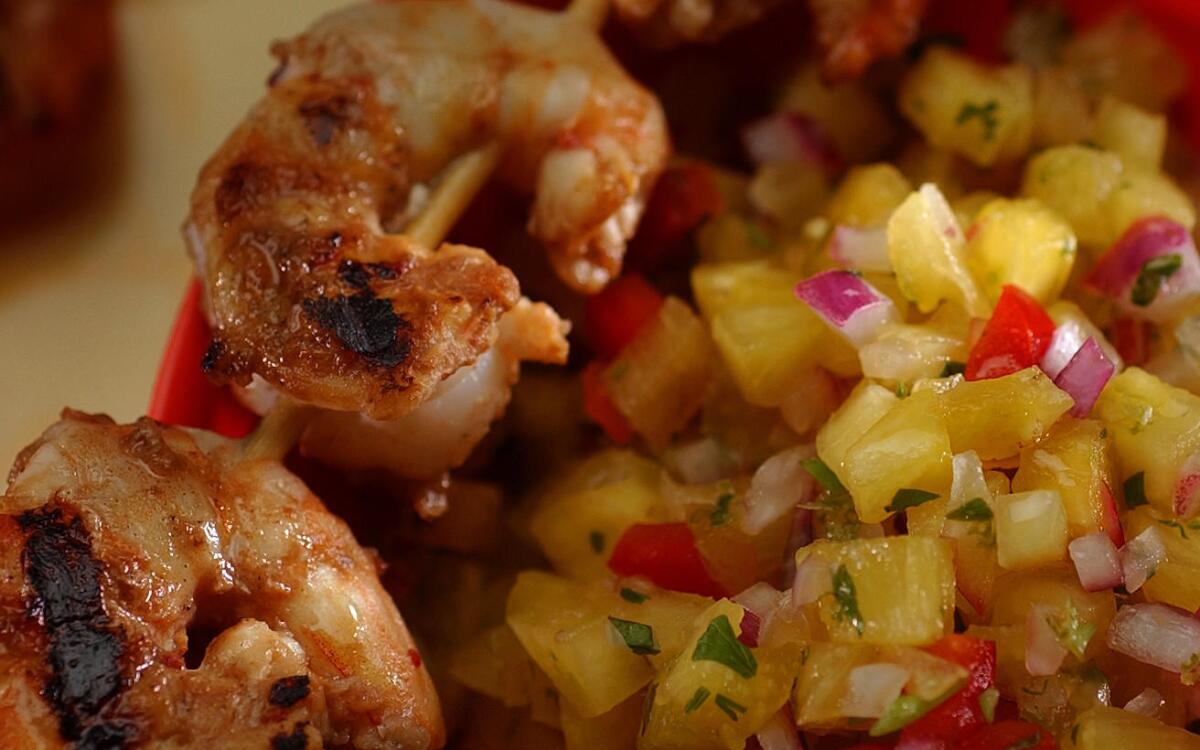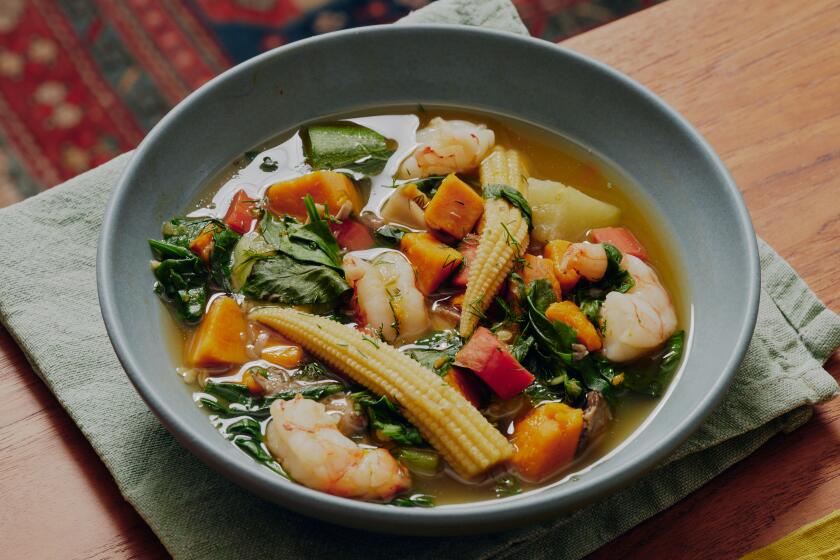Shrimp with tamarind recado (marinade)

This is the age of barbecue. Look, even French chefs are going along with it. French guys in tall white hats, cooking up a mess of ribs avec un certain savoir-faire!
And this is the time of year when barbecue writers bring out their sequels. Bobby Flay has followed up his 1999 “Boy Meets Grill” with “Boy Gets Grill” (Scribner, $30), another book brimming with enthusiasm -- and cute-guy photos of Flay; it’s tied in with a TV series, after all.
This time, Flay says, he’s doing homier, less restaurant-y recipes. They sound attractive, but they also feel like improvisations by a man with a distinctive style, so you may worry that if you cook them, somebody will say, “You know, you cook sort of like Bobby Flay.”
Among other known quantities on the cookbook trail, long-time barbecue writers Cheryl and Bill Jamison are all about “Chicken on the Grill” this year (Morrow $24.95). “The Good Housekeeping Grilling Cookbook” (Hearst Books, $19.95) has the usual trustworthy GH quality -- all the recipes are tested three times and have complete nutritional breakdowns.
And so on. The great mystery is that Stephen Raichlen, who usually seems to publish 30 or 40 barbecue books a year, doesn’t have anything out this season.
All the current barbecue cookbooks have a good deal in common. They go well beyond the traditional Southern, Tex-Mex and California styles to absorb influences from Latin America, the Caribbean, the Mediterranean, India, Thailand, China and Korea.
Actually, that’s the other story. This isn’t just the age of barbecue, it’s the age of strong, wild flavors.
The most serious of the season’s barbecue books is “Paul Kirk’s Championship Barbecue” (Harvard Common Press, $18.95), a manual for people who want to enter barbecue contests and those who’d just like to cook that way. It starts with 35 pages on the nuts and bolts of competition, from choosing which contest to enter to packing up after it’s over.
(Ever heard of “marking your brisket”? It’s a champion’s trick -- a way of trimming a beef brisket while it’s raw so that you can be sure of cutting across the grain of the meat after it’s done, when the grain is invisible because of browning and smoke.)
A few years ago Kirk published a book on barbecue sauces, and there are about 120 pages of sauces, rubs and the like here, even before you get to the 280 pages of recipes.
He prefers garlic powder and dried herbs over fresh flavorings because they don’t cause clumping. Heavy rubs, he says, “clog the meat’s pores” and keep the smoke flavor out.
Kirk has won a load of contests, including the American Royal in Memphis and the Jack Daniel’s World Championship Invitational. Maybe that’s why not one of the 575 recipes is illustrated by a photo.
His attitude seems to be, “I am the Baron of Barbecue; you can just take my word that this is a good dish.”
I’m willing to take his word. When he discusses the gyro sandwich in his chapter on sausages, you see it in a new light. Just on his say-so, I’d try his gyro mix (ground beef and lamb, with some untraditional pork for moistness) the way he suggests it, in a sausage casing.
Kirk is a serious cook, not just someone who has a little fun with a backyard grill or smoke pit.
There’s a certain elegance to his recipes, possibly reflecting the French Canadian side of his family. He even gives recipes for steak Diane and filet au poivre adapted to the grill.
Still, the most distinctive thing about “Paul Kirk’s Championship Barbecue” is that it’s for people who’d like to barbecue competitively. This is the sort of book that seriously advises that you buy a horse syringe from a veterinary supply house for brining your pork shoulder.
Silly trappings
Rick Browne coauthored “The Barbecue America Cookbook” last year, and this year’s “Grilling America” (Regan Books, $19.95) is in the same vein : visits to barbecue contests with lots of colorful photos and selected recipes from the cooks.
Kirk may see barbecue contests as arenas for competition, but Browne looks at them as community gatherings. He loves the silly, innocent trappings of the barbecue world -- the pig costumes, the teams named Byte My Ribs or the Three Brisketeers and so on.
Yes, it’s all pretty corny. On the other hand, it’s cheering to see your fellow citizens having homemade fun with such enthusiasm. You suspect that if we Americans weren’t such bone-deep cornballs, we probably wouldn’t be such a happy bunch of people.
That said, the corn can get in the way. Browne has recipes named “de-dip de-dip sauce,” “flamin’ gol-durn bananas” and “curses ... boiled agin’ taters,” which is not helpful when you’re thumbing through a volume looking for something to cook.
And the wheezing humor gets tiresome. The name of every Canadian recipe ends with “eh?” There’s a chapter of particularly labored jokiness contrasting an authentic barbecue place (an unsanitary dump) with a phony barbecue place (antiseptic and snooty).
Because most of the recipes come from contests Browne visited in the last year, they don’t represent a consistent aesthetic.
This is a compilation cookbook, with all the unevenness that goes with the genre. It’s like a Junior League or church group cookbook, only with sillier dish names, more smoke and obsessed people in pig masks.
On the other hand, it is an intriguing window on the world of barbecue. I’m not sure I’d want to make the roast beef injected with Velveeta or the chocolate cake with smoked frosting, but I’m glad to know about the Estonian American team that whittled its barbecue kettle out of a tree trunk.
“Grilling: Where There’s Smoke There’s Flavor” (Dorling Kindersley, $20) is part of a series of books co-written by French-born, London-based chef Eric Treuille (this one with Birgit Erath). The others are on pasta, bread and hors d’oeuvres.
Passport to seasonings
Treuille is quite at home with non-French flavors. In fact, he seems to have jumped feet first into the world melting pot of seasonings. Chipotle chiles, balsamic vinegar, garam masala, tropical fruits and wasabi are all over the place.
But he still has the disciplined French approach to cooking, and his recipes are harmoniously worked out. Among the side dishes, he has a version of tzatziki made with radishes instead of cucumbers, a cousin of hummus spiked with cumin and sour cream and a grilled pineapple glazed with rum.
The approach is so cosmopolitan, there are only a few hints that Treuille is European. One is the use of Moroccan cooking ideas, such as the herb sauce charmoula. The other is the habit of topping meat with a flavored butter. Treuille’s butters go beyond the traditional though: He makes cilantro chile butter and Kalamata olive butter.
There are no headnotes telling you what the recipe is like, but every recipe is illustrated in color.
Though this is a British production, the publisher has taken some trouble to adapt it for American readers. Eggplants aren’t called “aubergines,” cilantro isn’t “green coriander,” and the mail order sources are all domestic. A few more things could have been translated, though. What is “1 fresh red chile” -- a ripe jalapeno or a red bell pepper? You shouldn’t have to try a recipe to find out (it must be a bell pepper).
Still, these are attractive, approachable recipes, exotic but not too hard on the cook. And that’s what we all want, as barbecue season dawns in this Age of Barbecue.
Pineapple-lime salsa
Combine the pineapple, bell pepper, onion, cilantro, lime zest and juice. Add salt and hot pepper sauce to taste.
Cover and let stand for 30 minutes at room temperature. (Makes about 3 1/2 cups.)
Shrimp
Combine the tamarind paste, chipotle, garlic, salt and brown sugar. Add the shrimp and toss to coat evenly.
Thread 5 shrimp onto each skewer, cover with plastic wrap and refrigerate for 30 minutes. Can be made up to 2 hours ahead to this point.
Grill the skewers over medium-hot coals until the shrimp is pink and opaque, 3 minutes per side. Serve with pineapple-lime salsa.
Get our Cooking newsletter.
Your roundup of inspiring recipes and kitchen tricks.
You may occasionally receive promotional content from the Los Angeles Times.















